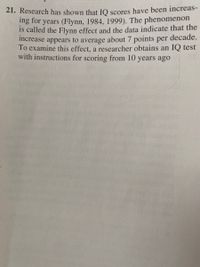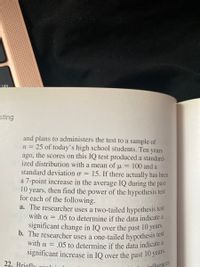


Given
a)
sample size
Ten years ago
The mean IQ score
The standard deviation
level of significance
Null hypothesis :
Alternate hypothesis :
Type II error occurs when a false null hypothesis is failed to reject.
The power of a hypothesis test is not committing type II error
The Z critical value for two tailed test with 5% level of significance is
As it is given that IQ score increasing by 7 points in a decade, let us consider right side critical value 1.96.
We reject the null hypothesis if test statistic
So we reject the null hypothesis if IQ score is greater than 105.88
The power of test is probability of rejecting null hypothesis given that alternate hypothesis is correct.
If alternate hypothesis is correct then the IQ score increase by 7 points, so mean IQ score is 107.
Power of test is calculated as shown below
With respect to Z table we get the following
Thus the power of the test is 64.43%
Trending nowThis is a popular solution!
Step by stepSolved in 2 steps

- 4arrow_forwardQuestion 3 According to a Kaiser Family Foundation survey, children aged 8 to 18 years in the United States spend an average of 190 minutes per day watching television. A recent random sample of 4 such children showed the following results: 200, 210, 230, 220 (in minutes) At the 5% level of significance, can you conclude that the current mean time spent watching television per day by children in this age group differs from 190 minutes? a)Step 1: State the null and alternative hypotheses. b)Step 2: Write down the appropriate test statistic (formula) , but first check assumptions c) Step 3 :Write down the rejection region of your test. d)Step 4: Compute the value of the test statistic (i) The sample mean = The sample standard deviation = (iii) The value of the test statistic = e) Step 5: State your conclusion: (i) Reject Ho Do not reject Ho (Just circle) (ii) In one sentence apply the results to the problem. f)What type of mistake could you have made in your hypothesis test? (Just circle…arrow_forward3a) The mean IQ of 200 patients in a psychiatric hospital is 91, with a variance of 16, and the distribution is highly negatively skewed. Between what two IQ scores would we expect to find at least 160 of the patients falling? b) If the distribution was mound-shaped and symmetrical, with the same mean and standard deviation as in part A, approximately how many patients would have IQ scores at or below the 5th percentile or above a score of 97? Answers: a) 82 to 100 b) 28.5 or 29arrow_forward
 MATLAB: An Introduction with ApplicationsStatisticsISBN:9781119256830Author:Amos GilatPublisher:John Wiley & Sons Inc
MATLAB: An Introduction with ApplicationsStatisticsISBN:9781119256830Author:Amos GilatPublisher:John Wiley & Sons Inc Probability and Statistics for Engineering and th...StatisticsISBN:9781305251809Author:Jay L. DevorePublisher:Cengage Learning
Probability and Statistics for Engineering and th...StatisticsISBN:9781305251809Author:Jay L. DevorePublisher:Cengage Learning Statistics for The Behavioral Sciences (MindTap C...StatisticsISBN:9781305504912Author:Frederick J Gravetter, Larry B. WallnauPublisher:Cengage Learning
Statistics for The Behavioral Sciences (MindTap C...StatisticsISBN:9781305504912Author:Frederick J Gravetter, Larry B. WallnauPublisher:Cengage Learning Elementary Statistics: Picturing the World (7th E...StatisticsISBN:9780134683416Author:Ron Larson, Betsy FarberPublisher:PEARSON
Elementary Statistics: Picturing the World (7th E...StatisticsISBN:9780134683416Author:Ron Larson, Betsy FarberPublisher:PEARSON The Basic Practice of StatisticsStatisticsISBN:9781319042578Author:David S. Moore, William I. Notz, Michael A. FlignerPublisher:W. H. Freeman
The Basic Practice of StatisticsStatisticsISBN:9781319042578Author:David S. Moore, William I. Notz, Michael A. FlignerPublisher:W. H. Freeman Introduction to the Practice of StatisticsStatisticsISBN:9781319013387Author:David S. Moore, George P. McCabe, Bruce A. CraigPublisher:W. H. Freeman
Introduction to the Practice of StatisticsStatisticsISBN:9781319013387Author:David S. Moore, George P. McCabe, Bruce A. CraigPublisher:W. H. Freeman





